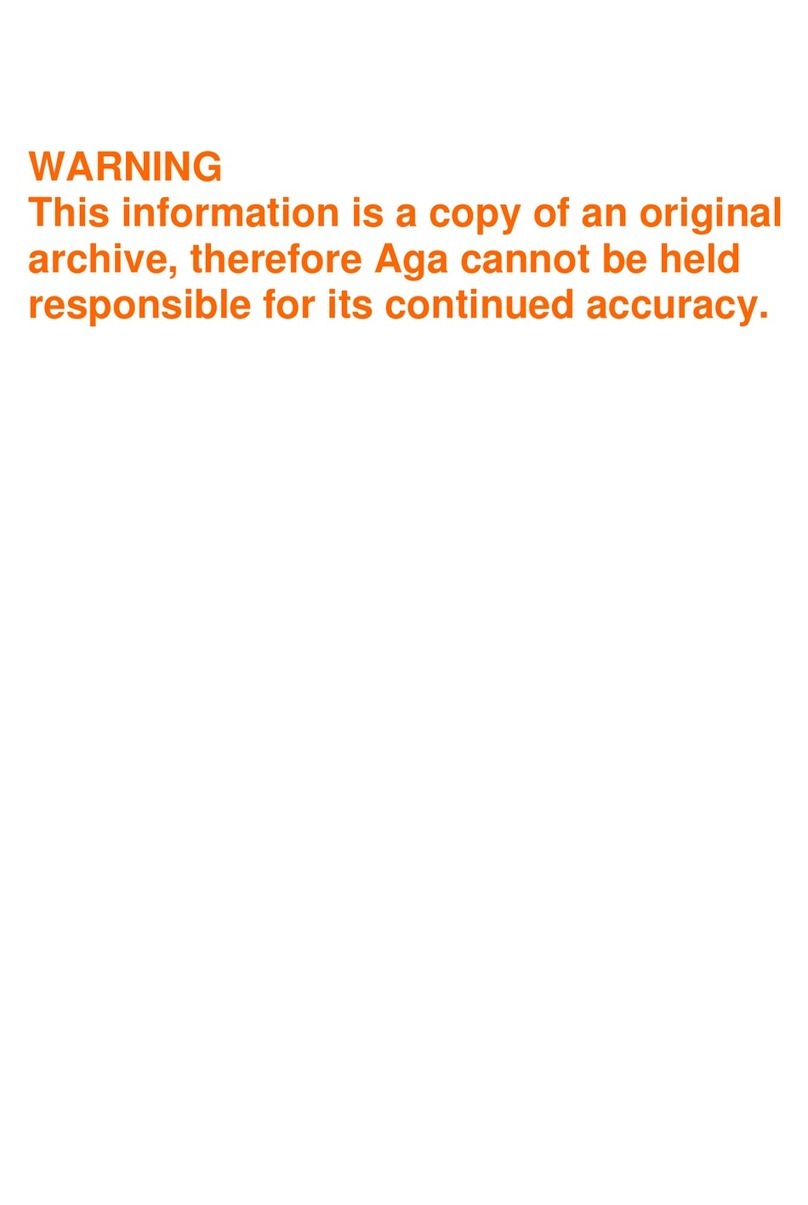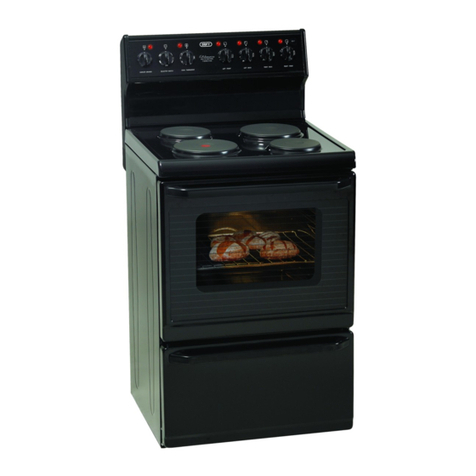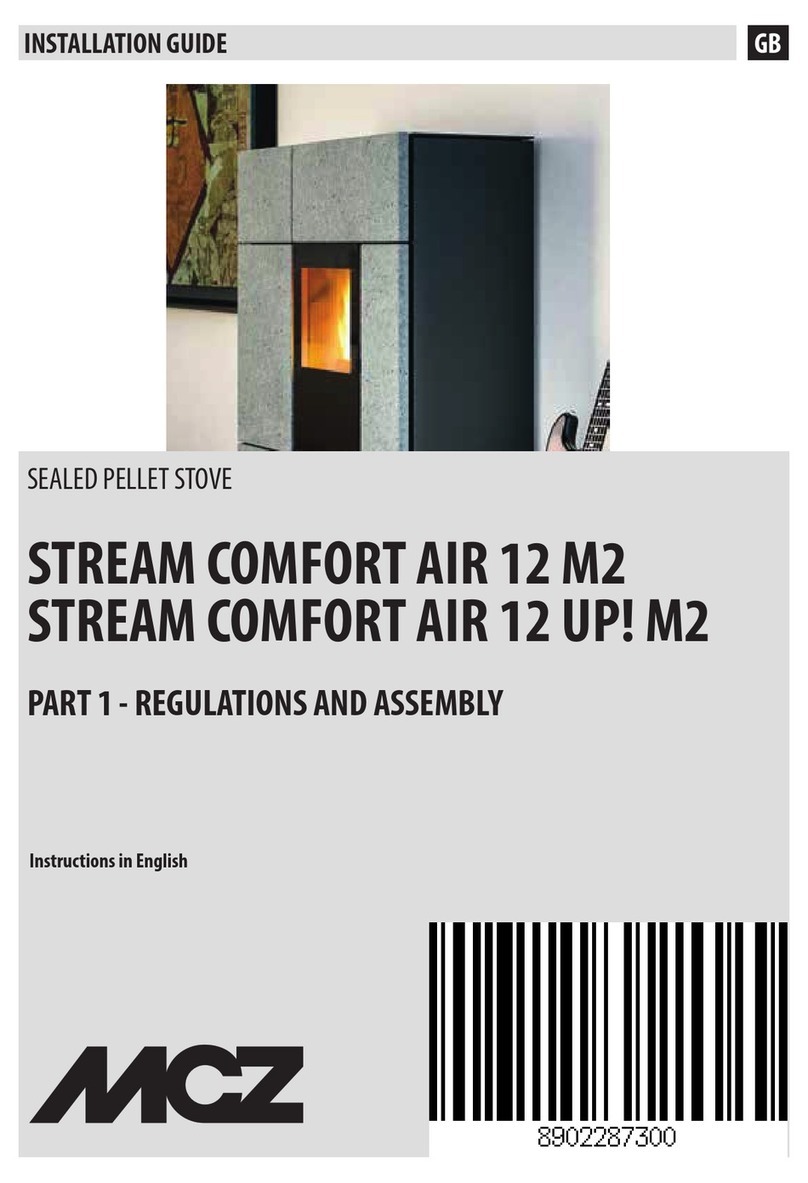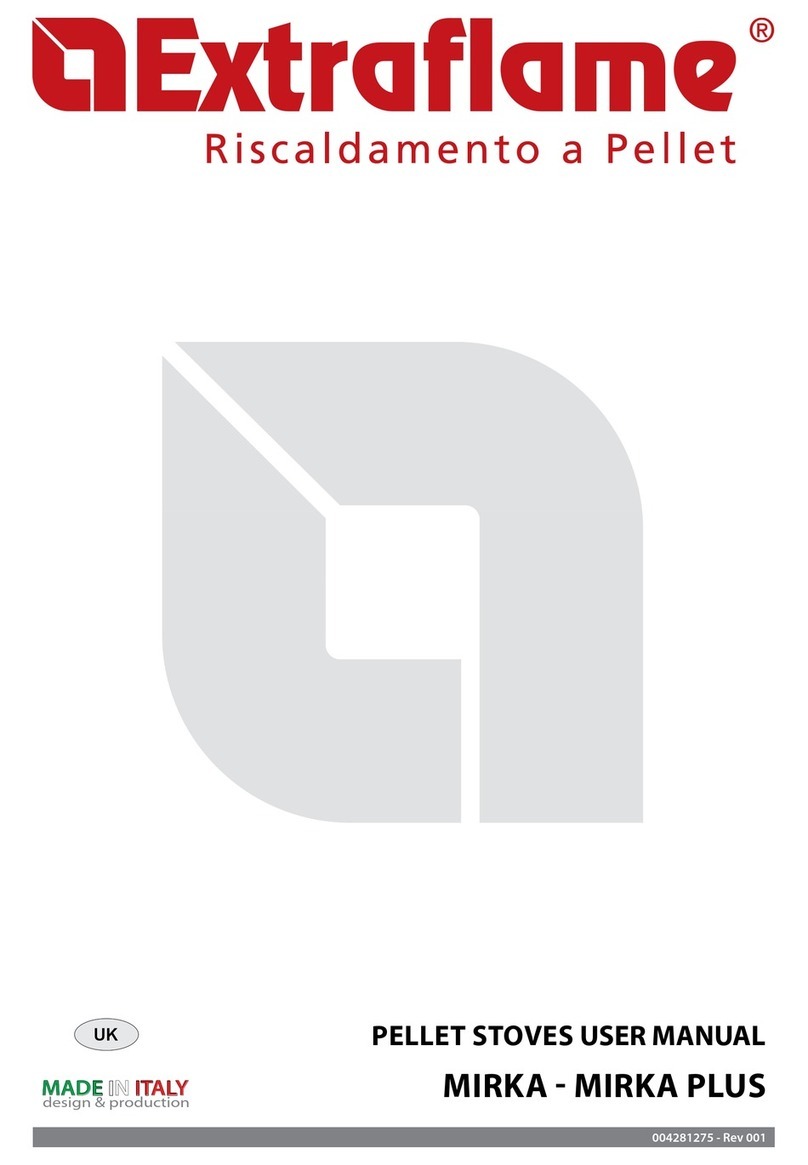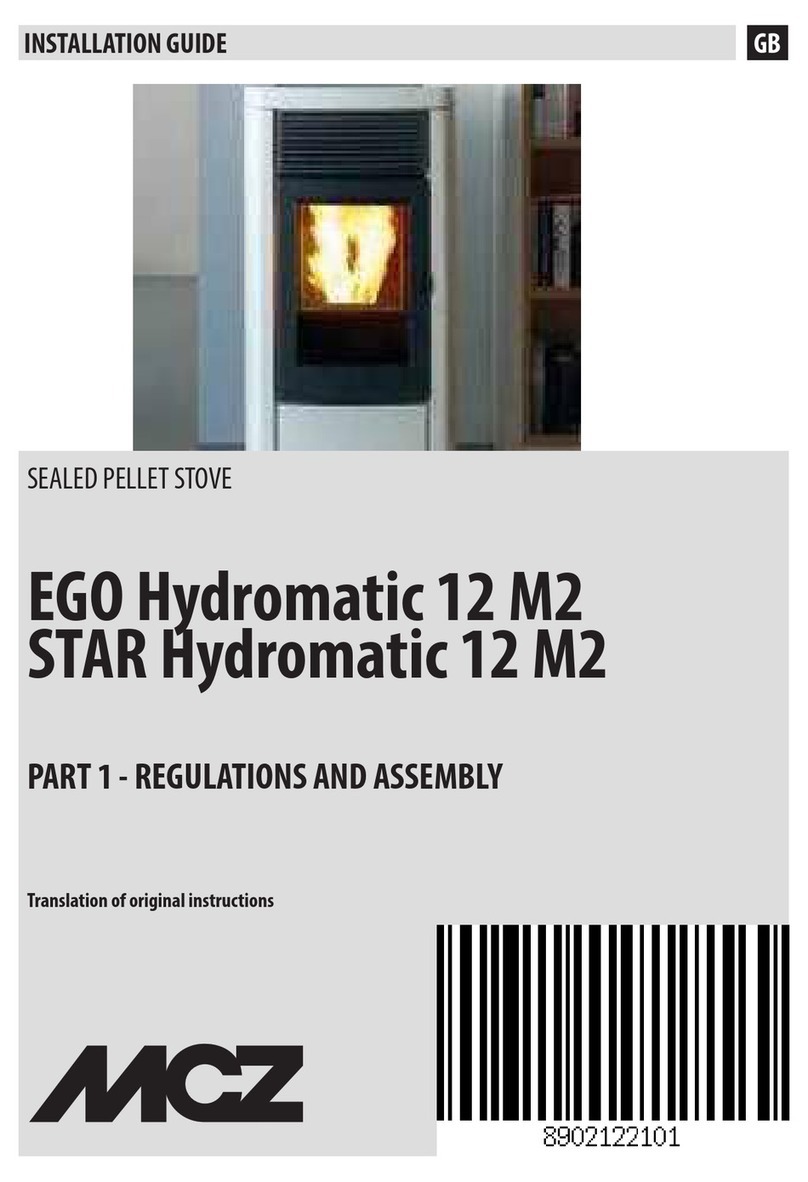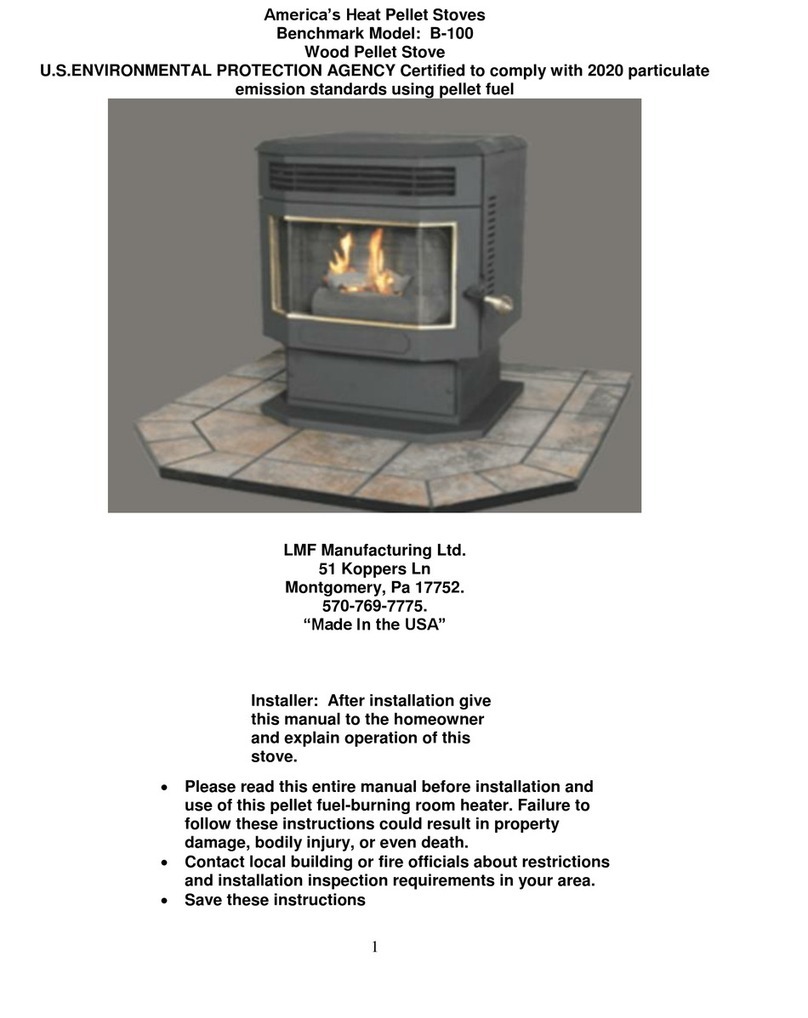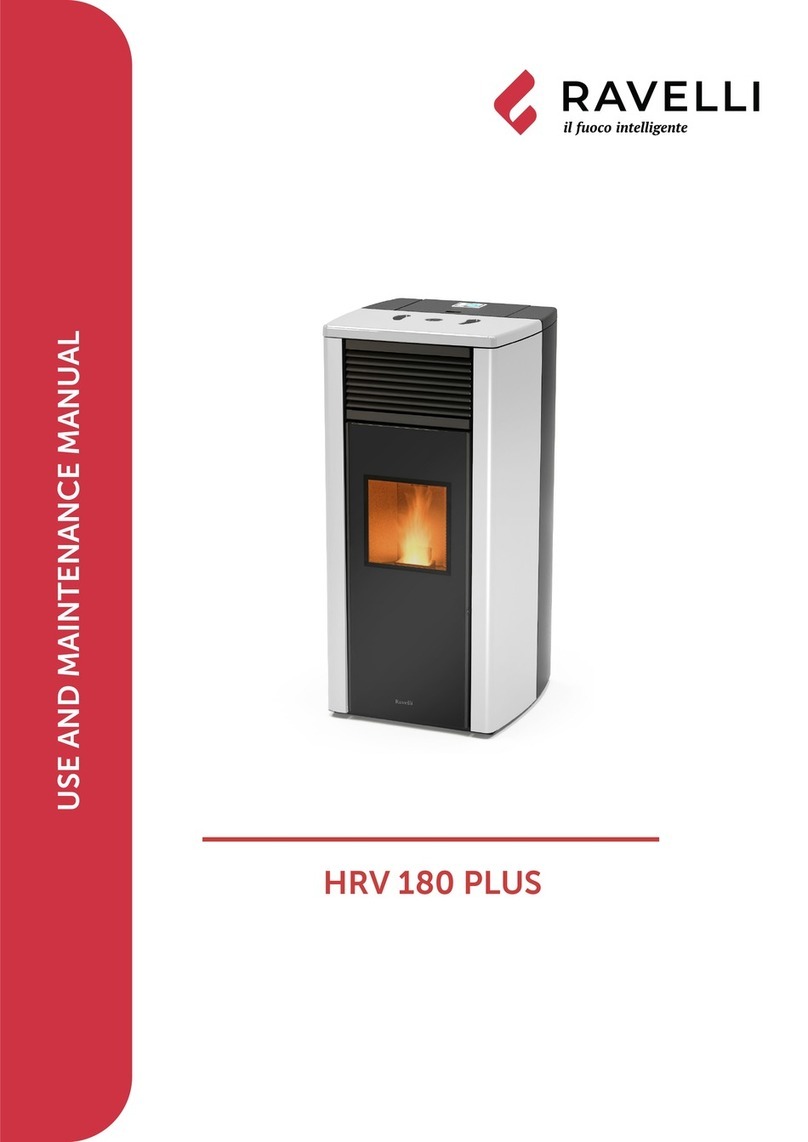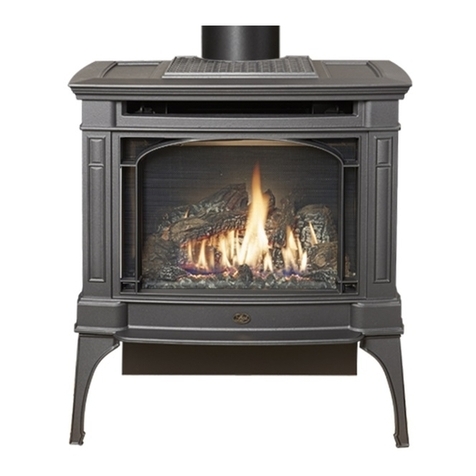Tropicair DUO Manual

INSTALLATION
DUO
SHOW ROOM:
03 379 0438
sales@tropicair.co.nz
1/29 Acheron Drive, Riccarton
www.tropicair.co.nz
& OPERATING INSTRUCTIONS

03
10
16
CONTENTS
installation instructions
operating instructions
cleaning & maintenance
first lighting
tip sheet
problem solving
warranty
parts
17
18
19
21
24
TESTING CERTIFICATION
CM1: Canterbury Method 1
NES: National Emission Standard
MODEL AS/NZS
2918:2001
CM1.6
(ULEB)
AS/NZS
4012:2014
AS/NZS
4013:2014 AUTHORISATION
NUMBER
DUO complies 23mg/MJ 74% 0.35g/kg 164316
MODEL AS/NZS
2918:2001 NES EFFICIENCY
(%)
EMISSIONS
FACTOR
(G/KG)
AUTHORISATION
NUMBER
DUO complies 9mg/MJ 79% 0.1g/kg 163595
02
wetback complies 33mg/MJ 73% 0.48g/kg 165314
wetback complies 12mg/MJ 77% 0.2g/kg 184265

INSTALLATION
INSTRUCTIONS
THE HEATING APPLIANCE & FLUE SYSTEM SHALL BE INSTALLED IN ACCORDANCE WITH AS/NZS 2918
& THE APPROPRIATE REQUIREMENTS OF THE RELEVANT BUILDING CODES
APPLIANCES INSTALLED IN ACCORDANCE WITH THIS STANDARD SHALL COMPLY WITH THE
REQUIREMENTS OF AS/NZS 4013 WHERE REQUIRED BY THE REGULATORY AUTHORITY i.e., THE
APPLIANCE SHALL BE IDENTIFIABLE BY A COMPLIANCE PLATE WITH THE MARKING 'TESTED TO
AS/NZS 4013'
ANY MODIFICATION OF THE APPLIANCE THAT HAS NOT BEEN APPROVED IN WRITING BY THE
TESTING AUTHORITY IS CONSIDERED TO BE IN BREACH OF THE APPROVAL GRANTED FOR
COMPLIANCE WITH AS/NZS 4013.
DO NOT STORE OR USE INFLAMMABLE VAPORS OR LIQUID IN THE VICINITY OF THIS APPLIANCE.
DO NOT CONNECT TO AN UNVENTED HOT WATER SYSTEM.
INSTALL IN ACCORDANCE WITH AS 3500.4.1 or NZS 4603 & APPROPRIATE REQUIREMENTS OF THE
RELEVANT BUILDING CODES.
WARNINGS
CAUTIONS
MIXING OF APPLIANCE OR FLUE SYSTEM COMPONENTS FROM DIFFERENT SOURCES OR MODIFYING THE
DIMENSIONAL SPECIFICATIONS OF COMPONENTS MAY RESULT IN HAZARDOUS CONDITIONS.
WHERE SUCH ACTIONS IS CONSIDERED, THE MANUFACTURER SHOULD BE CONSULTED IN THE FIRST INSTANCE.
CAUTION: CRACKED or BROKEN COMPONENTS e.g. DOOR GLASS or CERAMIC TILES MAY RENDER THE
INSTALLATION UNSAFE or INEFFICIENT.
The installation must comply with local council regulations. We recommend installation by trained NZHHA
qualified installers, who work in accordance with good trade practice.
The appliance should be installed in such a manner that parts are accessible for inspection & maintenance.
A clearance of at least 1 meter must be between the front of the unit and any building structure or substantial
immovable structure.
For Low base (standard), heat sensitive floors must be protected with an approved 46mm Insulated hearth.
The appliance must be seismically restrained (including the hearth), 8mm Masonry anchors are recommended
for concrete floors or 14g High Tensile Wood Techs of appropriate length for wooden floors.
Any appliance shall not be connected to a flue common with an open fireplace.
Duo must be fitted with the following Wet or Dry Damper control advice label as appropriate for model.
1.
2.
3.
4.
5.
6.
7.
Wet Model: After 21 min. Following light up the downdraft slide should be closed
Dry Model: After 15 min. Following light up the down draft slide should be closed
KEEP THESE INSTRUCTIONS FOR FUTURE REFERENCE
03

Total flue length must also be not less than 4.6m in height from floor protector
1000mm
minimum and
not lower than
point at which
flue intersects
at 3000mm
3000mm
more than 3000mm
3000mm or less
Note: Any flue systems may be fitted to the Duo provided a minimum 500mm X 500mm x 15mm ceiling plate a double
skinned 900mm long flue shield is fitted as per tested assembly.
Follow flue systems detail for specific component fitment instructions.
INSTALLATION
INSTRUCTIONS
INSTALLATION
600mm above roof ridge
Position the hearth & appliance on the floor. Drop a plumb-line from the ceiling to the center of the
Duo's flue spigot to mark the position where the flue will pass through ceiling.
Cut a 250mm x 250mm Square hole in the ceiling & roof above, & frame timber around 250mm ceiling
hole to support heat shield liners. Frame roof penetration if/as required. 40x40mm metal angles can be
used to support liners at purlin/roofline level (check manufacturers flue install instructions).
All flue joins are sealed at the time of installation using flue cement or a suitable exhaust cement and
fasten together with stainless steel pop-rivets or self-tapping screws (swagged end of the flue at
bottom). Secure the flue to the fire, drill through flue spigot on fire and secure with 2 to 3 s/s screws or
rivets. At this stage the ceiling plate should be fitted over flue & can be lifted up & screwed on.
500mm x 500mm x 15mm ceiling plate must be used.
A 900mm long double skinned shield must be fitted and can be fitted at his point.
Flash the roof to galvanised liner with an appropriate flashing method accepted by local council.
Where the chimney extends more than 1.3m (as per NZBC) above roof penetration, it will require
restraining stays. We recommend 16mm aluminium tubing for stays.
After installation of flue, ensure the unit is level & fixed through the hearth to the floor using seismic
restraints. Use 8mm masonry anchors or high tensile 14-gauge timber techs dependent on floor.
1.
2.
3.
4.
5.
6.
7.
8.
See flue installation diagram on the next page to further aid your installation but for actual flue details,
see the manufactures installation instructions.
04

INSTALLATION
INSTRUCTIONS
these are a guide only
- see instructions provided with flue
kit purchased
Liner swage points
Fit Cowl to complete
weatherproof assembly.
Fit support stays if liner
exceeds 1300mm out of roof
Flash liner to roof with
approved flashing method of
your council. We recommend
quality roof and gutter
sealant and 20mm steel
teach screws with neoprene
washers.
Cut a square hole and frame out
- see flue instructions for size
500mm x 500mm x 15mm
ceiling plate must be fitted
Flue swage points down
05
Fit a 900mm long Double
Skinned Flue shield

INSTALLATION
INSTRUCTIONS
Contact Tropicair if further clarity is required 03 379 0438 or www.tropicair.co.nz
clearances in mm to combustibles
CORNER ORIENTATION
clearances in mm to combustibles
STANDARD ORIENTATION
Standard model requires a
46mm thick insulting hearth
Tropicair advises that hearth
and clearance to combustibles
are absolute minimums.
Where practical these should
be exceeded
Side clearance is measured
from the cook top plate edge
Rear clearance is measured
from the rear of the heat
shielded casing
Corner clearance is measured
from rear corners of the heat
shielded casing
When offsetting backward
towards wall or corner, the
ceiling plate must be increased
by the same amount
(eg: Offsetting 100mm to the
rear. Standard ceiling plate of
500 x 500 x 15mm must now be
increased by 100mm at the
front. 350mm from centre to
the front edge of ceiling plate)
Minimum vertical clearance
from cooktop 1130mm
1146mm
996mm
996mm
523mm
620mm
385mm
385mm
45mm
365mm
300mm
823mm
835mm
300mm
620mm
110mm
65mm
365mm
690mm
250mm
300mm
06
Tropicair Duo Low Base (standard) clearances

INSTALLATION
INSTRUCTIONS
Contact Tropicair if further clarity is required 03 379 0438 or www.tropicair.co.nz
clearances in mm to combustibles
CORNER ORIENTATION
clearances in mm to combustibles
STANDARD ORIENTATION
Tropicair advises that hearth
and clearance to combustibles
are absolute minimums.
Where practical these should
be exceeded
Side clearance is measured
from the cook top plate edge.
Rear clearance is measured
from the rear of the heat
shielded casing.
Corner clearance is measured
from rear corners of the heat
shielded casing.
When offsetting backward
towards wall or corner, the
ceiling plate must be increased
by the same amount
(eg: Offsetting 100mm to the
front. 350mm from centre to
the front edge of ceiling plate)
minimum vertical clearance
from cooktop 1130mm
1216mm
1046mm
1045mm
523mm
620mm
385mm
385mm
45mm
365mm
300mm
823mm
905mm
380mm
620mm
110mm
65mm
365mm
690mm
250mm
300mm
07
Tropicair Duo Woodbase clearances

INSTALLATION
INSTRUCTIONS
Contact Tropicair if further clarity is required 03 379 0438 or www.tropicair.co.nz
clearances in mm to combustibles
CORNER ORIENTATION
clearances in mm to combustibles
STANDARD ORIENTATION
AS/NZS2918:2001 states:
All wetback appliances must
have 100mm working room for
maintenance.
As the Duo has clearances less
than 100 mm, the above MUST
be allowed for when installing.
1224mm
1051mm
1051mm
440mm
440mm
100mm
823mm
940mm
100mm
285mm
08
Tropicair Duo Wetback clearance changes

Contact Tropicair if further clarity is required 03 379 0438 or www.tropicair.co.nz
INSTALLATION
INSTRUCTIONS
Tropicair DUO wetback Pre-pipe information
front
Pipes centres 145mm right of centre
09
front
225mm standard base
(425mm if woodbase)
65mm
Always remember to factor hearth height in addition to these measurements
All measurements as written are from the top of the hearth
Under AS/NZS2918:2001 Minimum clearance
with a wetback is 100mm for access.
This WILL affect minimum hearth sizes

OPERATING
INSTRUCTIONS
WHAT WOOD TO USE
we recommend pine (soft wood)
- not only sustainable in NZ but one of the cheapest!
POWER OUT
not only does your Duo not need electricity to heat
your home - you can cook on the top too
ensure you use the right equipment to avoid damage
GREAT COMPANY
the atmosphere a fire puts out is both warm and cosy,
even romantic
10

OPERATING
INSTRUCTIONS
This below bird’s eye view shows the 2 controls and the position
they should be in for the first 15 - minute start cycle
(21 minute for wetback model)
START POSITION FOR 15 MINUTES
downdraft control rod out for start up
AIR CONTROL
Push in = High
Kindling should be 1kg of dry timber (Pine or soft wood is best and under 25% moisture) split
so it is no thicker than thumb sized - use with fire lighters.
Ensure control rods are in the correct positions as per drawing below.
Bottom door must stay closed during all times while in operation
Do not burn paper - it will clog up the flame stabilizer
See 1st lighting to bake on paint
Lift round center grate (Flame
Stabilizer) and twist left and
right vigorously to ensure ash is
free from holes and allows air
flow though the Flame Stabilizer
before each light.
You can push some loose ash
down to the bottom chamber,
but always leave a good bed of
ash about 20mm thick to
protect your plate
STARTING UP
11

OPERATING
INSTRUCTIONS
Select the 2 thickest pieces of
kindling and place in a triangle
pattern as shown in Fig #1.
Place minimum of 2 Fire lighters.
DO NOT put kindling or any type
of fuel in the bottom chamber.
Only the top chamber should be
loaded.
Place the next 3 pieces of
kindling across the triangle base
as shown Fig #2. Allow room to
light the fire lighters.
12
Apply the remaining kindling in
grid formation with an average of
3-4 per row as per Fig #3 until
fully set and ready to light. Light
the 2 front Firelighters and close
the door.
3 per row gives a taller kindling
stack and a faster start on
average.
Fig #1
Fig #2
Fig #3

It is very important that this intermediate load is split into 4.
For the fire to work properly in run mode the fire needs to establish a good
glowing coal base. Introducing large fuel pieces will make establishing a coal
base very difficult and will delay proper operation.
OPERATING
INSTRUCTIONS
Once the kindling is well established and collapses on itself (8-12 Minutes) introduce
the next Intermediate load. A piece of soft wood around 1.2kg split into 4 pieces.
Intermediate load should be softwood for best results
Once the intermediate fuel load is well alight (typically at 15 minutes) the
Duo can be switched to run mode. Should your Duo cease to operate or
operate oddly, open the control rod for 3 more minutes before switching
back to run mode again
If wood moisture is too high, this may need to be repeated several times
13

OPERATING
INSTRUCTIONS
This below bird’s eye view shows the 2 controls and the
position they should be after the first 15 - minute start cycle.
GENERAL OPERATION 'RUN POSITION'
downdraft control rod
Push rod in after 15
minutes to Run position
AIR CONTROL
Push in = High
By pushing the downdraft control rod all the way in the fire will switch to run
mode aka downdraft
For the first 5 -10 minutes after down drafting the fire may diminish slightly as
it continues to heat up the bottom half of the fire
After the DUO has been running for approx. 25 - 30 minutes total, the next load
of fuel (1.5kg - 2.5kg) can be added.
By the time you are ready to add further loads, your DUO will be at optimum
running temperature. See 'reloading fuel' diagram regarding reloading fuel.
RUN MODE
DOWNDRAFT
downdraft
14

OPERATING
INSTRUCTIONS
downdraft control rod
AIR CONTROL
Push in = High
Pull out = Low
At this point the Air controller can be pulled out to set the fire to low if desired.
Switching to start mode (downdraft control rod out) when at running temperatures
will reduce your heat output and reduce your efficiency; Wood will be consumed
much faster. This will also super heat areas inside the fire that are not designed for
sustained high temperatures. This should only be done sparingly to aid when
reloading fuel.
Being left in start position for extended periods can and will cause damage, excessive
pollution and can void your warranty. Run position (downdraft control rod in) should
be engaged constantly, unless reloading fuel. Should you need to have the control
rod in the start position for more than 5 minutes each hour after lighting - call
Tropicair for operational advice.
Always use the fire correctly to achieve maximum benefit, keep emissions minimal
and use the least amount of fuel.
If the fire loses too much heat and goes out, do not attempt to restart the fire when
hot. The Duo should not be hot to the touch prior to lighting.
Generally, ash does not need to be removed from the top chamber unless it begins to
cover the flame stabilizer in the middle of top chamber. It generally finds its way to
the bottom in the lower gasification chamber. Should the ash begin to build up, push
loose ash down the center hole, always leaving a layer of ash around 20mm thick.
RELOADING FUEL
Pull out control rod before opening fire door1.
2. Open door gently, load fuel
3. Close door, push in downdraft control rod
15

To empty ash from the bottom gasification chamber, wait for the Duo to go out. Once
cold (preferable the day after the last use) open the lower door and dispose of the
ash responsibly.
To clean the glass: dirty glass is a general sign of insufficient temperature or very
sappy oily wood or wood high in moisture over 25%
Tough staining – black/dark brown. Moisten a cloth or scrunched newspaper and
dip the cloth/paper in the ash of the top fuel chamber and rub the wet ash into the
dirty area. A very hot fire with pine will often remove this or leave the film as more
of a light discoloration.
Mild staining – light brown/white. Normally a damp cloth, towelette or baby wipe
is sufficient to return the glass to a clean state. Ash can be used for tough spot
staining.
Flue cleaning and servicing must be performed by a competent appointed technician.
Servicemen must have a fundamental understanding of the fire and know the best
way to clean and maintain it. It is also a condition of the CRC (ECAN Global Resource
Consent) by which the fire is installed in Canterbury.
As the Duo is many times cleaner burning than a conventional log fire there may be
reduced frequency of flue cleaning required. Flue cleaning and maintenance Must be
done within 24 months of the last maintenance date, insurers should be advised of
our 24-month requirements. Consult your insurer or read their PDS to ensure
compliance with insurance requirements.
The High Temperature Paint (HTP) finish can be cleaned with a soft damp cloth. Do
not use abrasive cleaners or abrasive cloths as this will remove the HTP finish. If your
paint finish needs reapplication, HPT touch up cans (Metallic Black) can be purchased
where refinishing is desired.
Tips to minimise ash build up: burn only soft woods (do not burn paper), make sure flame
stabilizer is clear of ash on every light up. You should be able to clearly see 1 rows of
holes in your flame stabilizer
Tropicair carries a full range of spares for your Duo that can be ordered directly
www.tropicair.co.nz | 03 379 0438
OPERATING
INSTRUCTIONS
CLEANING & MAINTENANCE
16

For this first lighting, there are things you should do and things you should expect.
Your fire is coated in a high temperature paint (HPT) that will bake on during the first
firing. This will produce a foul odour and smoke. Doors and windows should be opened to
allow the smell too clear. We anticipate up to 3 hours to fully cure the paint.
Hour 1. Start your fire as per the start sequence at the beginning of this document. Run
your fire for an hour to establish a good coal base. Prepare 4+kg of wood cut so it has an
end around the size of a tennis ball, open the door slowly, load the wood (as much as you
can physically fit in)
Hour 2. Close the door and LEAVE THE CONTROL ROD IN START POSITION. This will
heat the flue higher than it is likely to get again and will bake the high temperature paint
on properly.
If the load burns down faster than 1 hour, you can reload and resume normal operation
with the control rod in start position.
Hour 3. Run for the next hour as per normal using the remainder of the 4+kg of wood
prepared earlier. Fit as much in as possible to encourage the highest temperature.
If the flue begins to glow red hot (or appliance makes bad noises) close the control rod to
run and set air control to low fire (Pull out air control - short rod out to right) and call
Tropicair for advice. Ticking or a tinking/pinging sound from metal expanding as it heats
up is very normal and is not abnormal.
Once the hour has passed or the load is gone, resume normal operation. If your fire is not
used for an extended period (week or more) it isn’t uncommon for a fine layer of dust to
settle on the fire and flue. If not wiped with a damp cloth before lighting, you may have a
burnt dust smell on the next lighting (similar to the smell of an old electric bar heater).
If you are getting the baking paint smell on the second or third light, the above process
may need to be repeated. If after the process is conducted three times and you are still
getting paint fuming smells, contact Tropicair for advice 03 379 0438
OPERATING
INSTRUCTIONS
FIRST LIGHTING
BAKING ON THE PAINT
17

Tropicair ULEB’s need to be treated a little differently to your traditional wood burner, we have put
together an informational Tip Sheet so that you can get the best out of your ULEB.
Wood
We recommend burning soft woods that have been seasoned or kiln dried. Wood that has high moisture
content, very sappy or full of resin will cause jamming of the Flue’s downdraught lever, creosote will drip
down your flue and onto the moving plate, causing this to jam. If this happens, give the lever a hard push or
pull. If this remains jammed, you will need to remove the top baffle plate in the top chamber and use a
hammer to dislodge the plate. Use the fire for about an hour with the flue lever open to burn off any
creosote that may have built up, this can take a bit of time to clear depending on how much wood you have
already burned in this condition.
Top Chamber
As you use your fire, Ash will start to build up on the Stainless-Steel Middle Baffle (steel plate), please
ensure that you leave a layer of Ash on the top plate. Ash acts as an insulator for the steel plate and will
help protect the lifespan of this part. If Ash is continually cleared from this area, you will start to notice
excessive wrapping of the plate, though some wrapping isn’t abnormal. You can push Ash down the centre
hole to help keep the top chamber tidy, but always leave a good layer of Ash around 20mm thick.
Flame Stabilizer | Centre Grate in Top Chamber
Your Flame Stabilizer has the biggest job in your ULEB; it is the part that will need to be replaced when it is
no longer able to do its job. The Flame Stabilizer must be cleared of Ash each time you light the fire, clearing
of Ash around the hole allows the air to flow down past the Flame Stabilizer. If this part is not cleared of Ash,
it will deteriorate a lot faster than needed.
Bottom Chamber
The Bottom Chamber door should be kept closed at all times during operation, this is where all the
emissions are being re-burnt before being released out the sides of the fire and up the flue.
Door Glass
We would recommend cleaning your door glass before each light with a wet cloth or paper towel and then
dry it with a dry cloth or paper towel. Burning the correct wood will also ensure a cleaner glass especially at
the bottom.
Top Baffle Plate
If your Top Baffle Plate falls down during operation, do not attempt to put it back while the fire going, wait
for the fire to be cold and position this back into the correct position, slotting this back into the 2 holes at
the back of the fire, you will know it is correctly located as you will no longer have any sideways movement.
Once this is back in, put the retaining blocks back in on each side at the front of the baffle to
ensure it is sitting securely back in place and is not able to move. If you are missing these 2
retaining blocks, please let Tropicair know.
OPERATING
INSTRUCTIONS
ULEB TIP SHEET
18

High moisture content in your wood is the most likely cause. Damp wood during start
up loses so much heat and energy trying to dry the wood that it cannot effectively
raise the fires temperature to cleanly combust. Do Not start your fire with damp fuel
with a moisture content above 25% Dry weight. For best results, kindling should be
16-18% moisture.
Your unit has a manual damper to engage/disengage downdraft this should be
opened as per ‘refueling’ to stop this occurring. Opening the damper 30 seconds
before loading fuel may also help minimize this.
Down draft models: downdraft fires run lower flue draft than a conventional log fire.
Therefore, if the door is pulled open too vigorously or a kitchen extractor fan or toilet
fan is left running this can reverse the airflow in a flue system and cause this
symptom.
Fire has been allowed to lose too much heat prior to fuel loading. The fire may need
to be loaded with several smaller pieces of wood. See start up procedure and repeat
from Intermediate load.
The below scenarios are answered for your assistance, though should you be
encountering issues not described here or are not confident about an issue then feel free
to contact Tropicair www.tropicair.co.nz | 03 379 0438.
The glass gets dirty (dark brown) very quickly; especially the bottom glass and the fire
will not stay in down draft.
NOTE: It is an offence under the Canterbury Air Plan to burn wood with greater than
25% moisture.
Sometimes when I load new wood smoke comes out of the top of the door opening
Every time I load new wood smoke comes out of the top of the door opening.
If this has been the case since the very first use of the fire, then contact the installation
company that performed the work as you may need to pay them to return to try
lengthening the flue system or altering the cowl type. While fires are always set to
minimum ECAN heights and Minimum AS/NZS2918:2001 standards, this does not
guarantee that the flue draw is sufficient. Some flues need a little tuning to the
environment as roof pitch, prevailing wind, land topography, trees and even your
neighbors’ trees and rooves can affect your flues performance. Try to be as accurate
in your description of what and when this occurs as this will assist the technician
to diagnose the issue/s.
OPERATING
INSTRUCTIONS
PROBLEM SOLVING
FAQ
19

Door seals: Inspect the door seal visually to see that no sections are missing or have
become hard and glass like. If they are, replace the door seal.
Door adjustment: In the closed position, check there is no play in the door seal (hold
door handle near the base and pull in and out quickly to feel for movement or
rattling). It there is play, adjust this out with a 10mm spanner by rotating the adjusting
cam and tightening in the new position. If you’re unsure how to adjust this, please call
your nearest technician for help/advice.
Reloading and/or fuel supply: if the fire loses too much temperature or glowing coal
mass the fire may stall and be unable to ignite combustion gases. To quickly correct
this, you can open the control rod to the start position. If this does not assist to ignite
the un- burnt gases in the lower chamber after 5-10 seconds, (gently, slowly and with
a solid grasp of the door handle) open the top door very slowly to increase air flow
and this additional air should correct the combustion in the lower chamber.
Check your baffles and bricks are all in correctly
After an hour or so (but never before then) when I load new wood smoke comes out of
the top of the door opening.
This is generally a vacuum related issue and most common in newer homes and less
common in homes 20+ years old. Your fire uses a lot of air for combustion, this ‘air’ has to
come into the house from somewhere to replace the air being used for combustion, if it
doesn’t then your house begins to swing from neutral pressure to a vacuum. This is most
common in new homes where windows and doors are sealed tight. It can be worse in
purpose-built eco houses/passive houses built with Airtight Membrane wrap designed to
be 100% isolated from outside air. If you are experiencing vacuum related Issues, contact
a builder about having a vent added in the wall behind the fire (or close by) to allow air
flow. For a quick fix, open a window closest to the fire about 20mm to allow air in.
Sometimes the flame in the bottom chamber goes out and a small time later goes ‘pooof’
and reignites. Sometimes it blows a little smoke out around the door too.
ULEB’s are mostly fires that work by down-drafting flue gases. This process is only
possible when door seal correctly and when combustion temperatures are in the
optimum range.
Leaving the rod in start position for several minute may also help. Do not open the lower
chamber door.
If this issue occurs more than once, then running your fire a little hotter and fuelling more
often may be required (if the door seals and adjustments are correct). The Duo can
only pull gas down for combustion if the flue is hot enough to pull the hot air up
OPERATING INSTRUCTIONS PROBLEM SOLVING
FAQ
20
This manual suits for next models
1
Popular Stove manuals by other brands
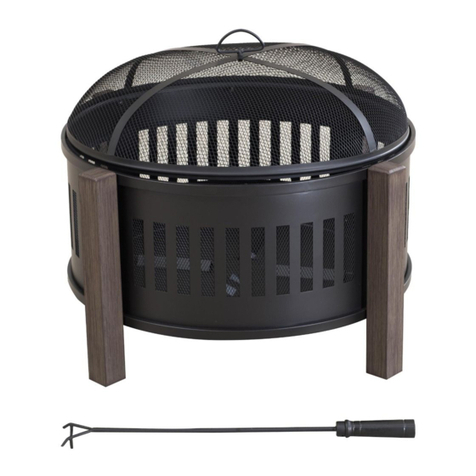
Sunjoy
Sunjoy A301019900 Assembly instructions

Valor Fires
Valor Fires BRUNSWICK operating instructions
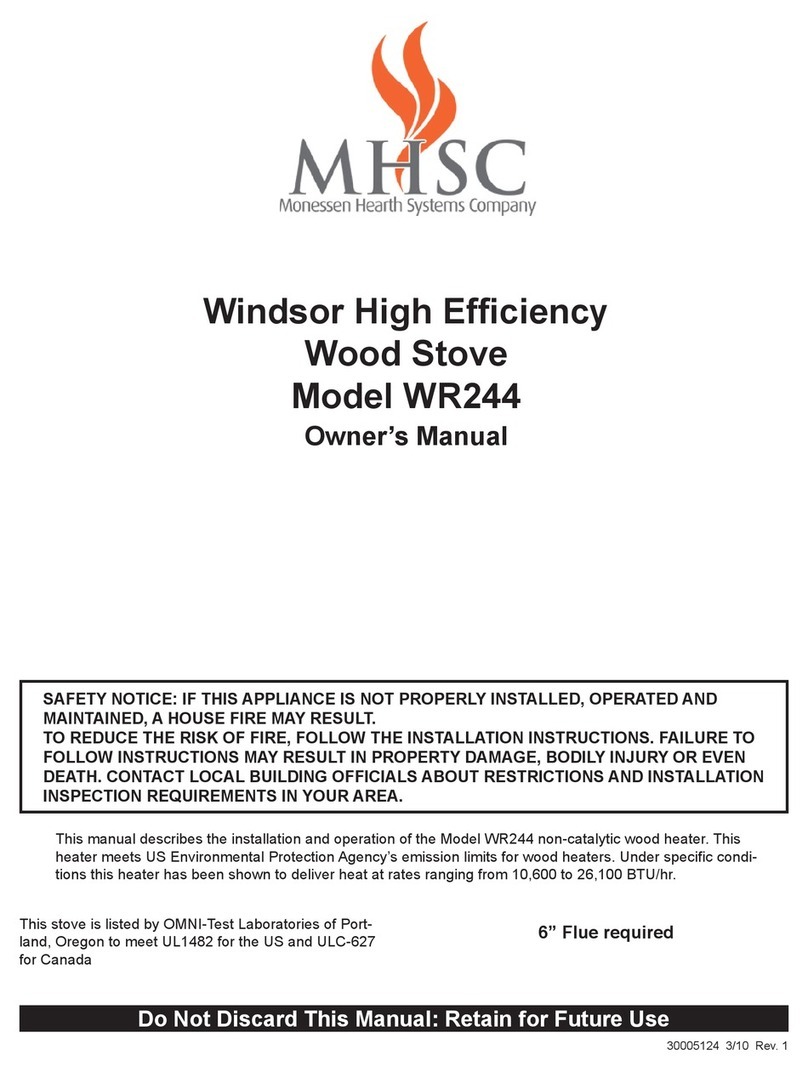
MHSC
MHSC Windsor WR244 owner's manual

Hunter
Hunter Herald Inset 5 Installation and operating instructions

Breckwell
Breckwell SP6000 owner's manual
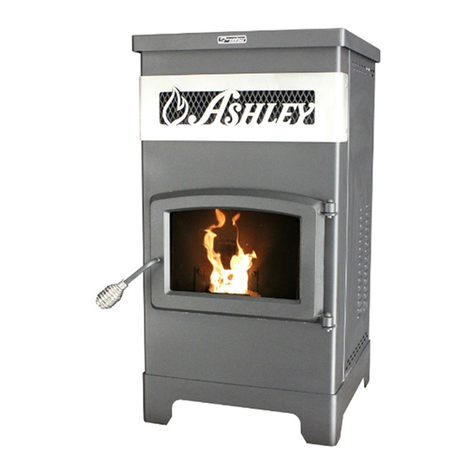
Ashley
Ashley AP5770 Owner’s Instruction and Operation Manual


